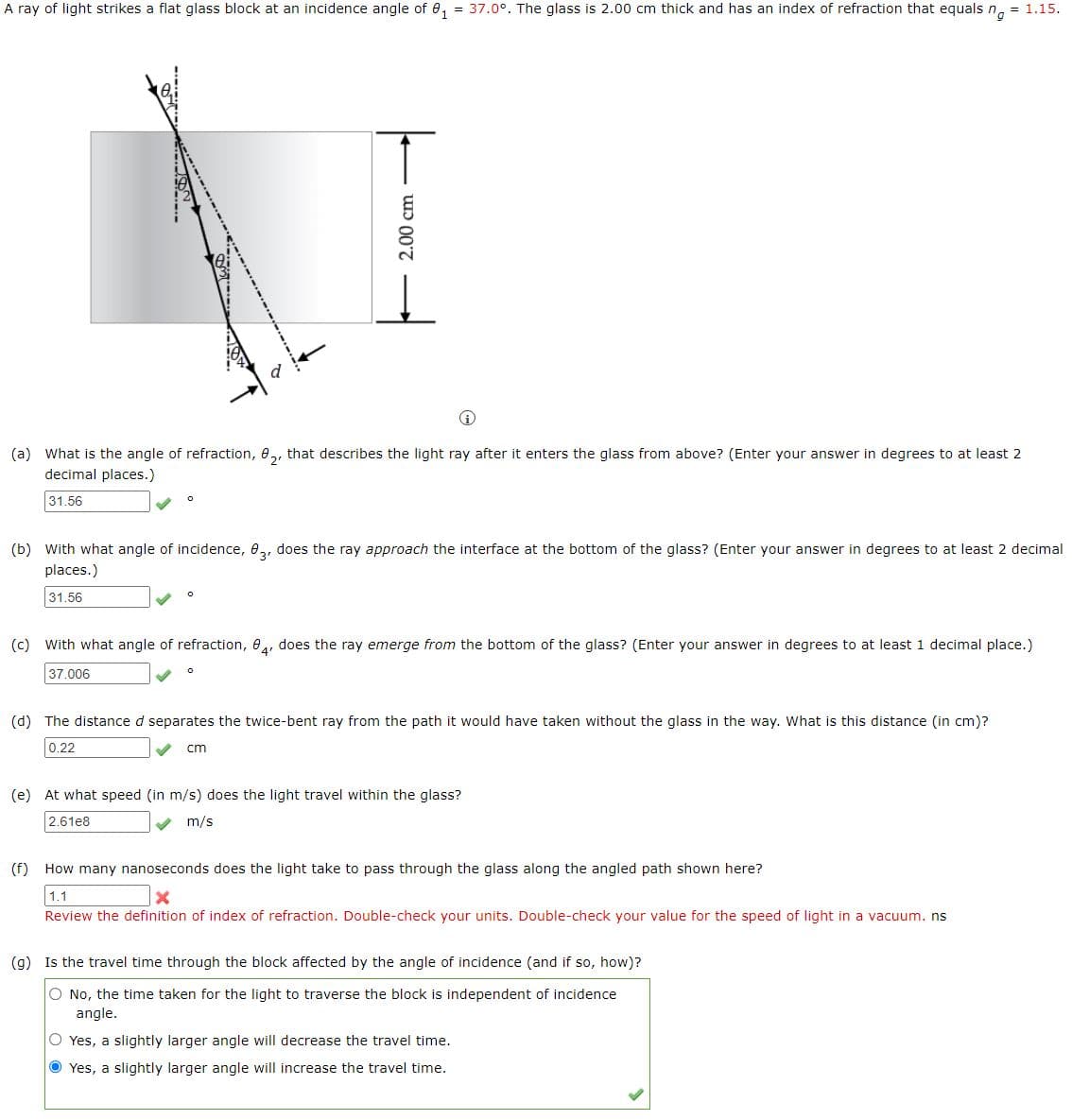How many nanoseconds does the light take to pass through the glass along the angled path shown here? 1.1 Review the definition of index of refraction. Double-check your units. Double-check your value for the speed of light in a va
How many nanoseconds does the light take to pass through the glass along the angled path shown here? 1.1 Review the definition of index of refraction. Double-check your units. Double-check your value for the speed of light in a va
Principles of Physics: A Calculus-Based Text
5th Edition
ISBN:9781133104261
Author:Raymond A. Serway, John W. Jewett
Publisher:Raymond A. Serway, John W. Jewett
Chapter25: Reflection And Refraction Of Light
Section: Chapter Questions
Problem 16P
Related questions
Question
Please read and answer (f).

Transcribed Image Text:A ray of light strikes a flat glass block at an incidence angle of e, = 37.0°. The glass is 2.00 cm thick and has an index of refraction that equals n, = 1.15.
(a) What is the angle of refraction, 0,, that describes the light ray after it enters the glass from above? (Enter your answer in degrees to at least 2
decimal places.)
31.56
(b) With what angle of incidence, 02, does the ray approach the interface at the bottom of the glass? (Enter your answer in degrees to at least 2 decimal
places.)
31.56
(c) With what angle of refraction, 8, does the ray emerge from the bottom of the glass? (Enter your answer in degrees to at least 1 decimal place.)
37.006
(d) The distance d separates the twice-bent ray from the path it would have taken without the glass in the way. What is this distance (in cm)?
0.22
cm
(e) At what speed (in m/s) does the light travel within the glass?
2.61e8
m/s
(f) How many nanoseconds does the light take to pass through the glass along the angled path shown here?
1.1
Review the definition of index of refraction. Double-check your units. Double-check your value for the speed of light in a vacuum. ns
(g) Is the travel time through the block affected by the angle of incidence (and if so, how)?
O No, the time taken for the light to traverse the block is independent of incidence
angle.
O Yes, a slightly larger angle will decrease the travel time.
O Yes, a slightly larger angle will increase the travel time.
2.00 cm
Expert Solution
This question has been solved!
Explore an expertly crafted, step-by-step solution for a thorough understanding of key concepts.
This is a popular solution!
Trending now
This is a popular solution!
Step by step
Solved in 2 steps with 2 images

Knowledge Booster
Learn more about
Need a deep-dive on the concept behind this application? Look no further. Learn more about this topic, physics and related others by exploring similar questions and additional content below.Recommended textbooks for you

Principles of Physics: A Calculus-Based Text
Physics
ISBN:
9781133104261
Author:
Raymond A. Serway, John W. Jewett
Publisher:
Cengage Learning

An Introduction to Physical Science
Physics
ISBN:
9781305079137
Author:
James Shipman, Jerry D. Wilson, Charles A. Higgins, Omar Torres
Publisher:
Cengage Learning

Principles of Physics: A Calculus-Based Text
Physics
ISBN:
9781133104261
Author:
Raymond A. Serway, John W. Jewett
Publisher:
Cengage Learning

An Introduction to Physical Science
Physics
ISBN:
9781305079137
Author:
James Shipman, Jerry D. Wilson, Charles A. Higgins, Omar Torres
Publisher:
Cengage Learning